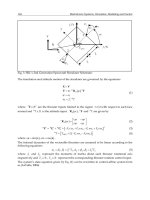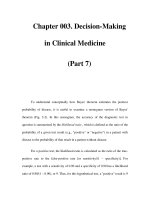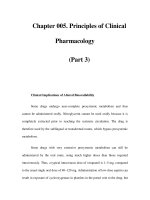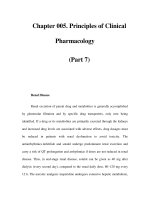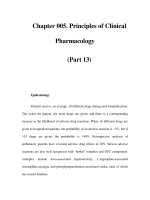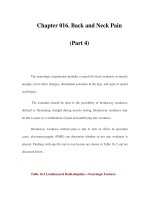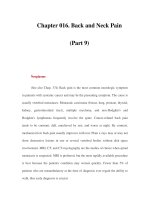Chapter 116. Immunization Principles and Vaccine Use (Part 7) docx
Bạn đang xem bản rút gọn của tài liệu. Xem và tải ngay bản đầy đủ của tài liệu tại đây (43.75 KB, 5 trang )
Chapter 116. Immunization Principles
and Vaccine Use
(Part 7)
As noted above, the number of licensed vaccines and the strategies for their
best use change constantly as new products, new indications, and new information
become available. The Advisory Committee on Immunization Practices (ACIP)
regularly amends immunization recommendations to reflect the evolution of
vaccines and vaccination policy in the United States. Changes for 2006 include the
following points:
to implement standing orders to administer hepatitis B vaccine—soon
after birth and before hospital discharge—to all infants except those with
documented hepatitis B–negative mothers;
to target adults at high risk for hepatitis B vaccination;
to use a new tetanus toxoid/reduced-dose diphtheria toxoid plus
acellular pertussis combination vaccine (Tdap) formulated for adolescents and
adults in place of Td;
to provide meningococcal conjugate vaccine (MCV4) to all children
at 11–12 years of age, to unvaccinated adolescents at age 15, and to all college
freshmen living in dormitories;
to administer hepatitis A vaccine to all children at 1 year of age;
to administer three doses of the newly licensed rotavirus vaccine at 2,
4, and 6 months of age, with the first dose given by 12 weeks of age and the last
by 32 weeks of age;
to immunize children 6 months to 5 years of age with influenza
vaccine and to expand routine use of the vaccine for their household contacts and
out-of-home caregivers;
to administer Tdap to protect health care personnel from pertussis
and to reduce their potential to transmit nosocomial infections, assigning the
highest priority to those who have direct contact with infants <1 year old; and
to administer HPV vaccine routinely to girls at 11–12 years of age.
Vaccines for Routine Use
Infants and Children
It is current practice for all children in the United States to receive DTaP,
poliovirus, MMR, Hib, hepatitis B, and varicella vaccines and to receive
pneumococcal conjugate, hepatitis A, and rotavirus vaccines in the absence of
specific contraindications (Fig. 116-1; www.cdc.gov/vaccines/vpd-vac/vaccines-
list.htm). Annual influenza seasonal vaccine is recommended for all children 6
months to 5 years old and to other children who have certain risk factors or who
reside with persons with certain chronic disorders. In several European countries,
meningococcal C conjugate vaccine is routinely recommended for children.
Teenagers
It is now recommended that all adolescents routinely receive quadrivalent
meningococcal conjugate vaccine for serogroups A, C, Y, and W135 and the new-
formulation Tdap vaccine. Girls should be given HPV vaccine, ideally at the age
of 11–12 years but certainly before becoming sexually active (Fig. 116-1;
www.cdc.gov/vaccines/recs/schedules/teen-schedule.htm).
Adults, Including College Students
(Fig. 116-2) Immunization recommendations for adults (≥18 years old) fall
into four categories: (1) routine vaccines for all adults; (2) vaccines for high-risk
exposure groups (health care and other institutional workers, prisoners, students,
military personnel, travelers to endemic areas, injection drug users, and men who
have sex with men); (3) vaccines for persons at high risk for severe outcomes of
infection (pregnant women; the elderly; persons with chronic medical conditions,
including diabetes, alcoholism, immunodeficiency, and renal, hepatic, respiratory,
or cardiac disease); and (4) vaccines for household contacts of persons in group 3.
Because a substantial proportion of adults in the United States no longer
have protective levels of antibodies to tetanus or diphtheria, all adults should
receive routine booster doses of Td every 10 years. For those under age 65 years,
one-time substitution of Tdap suitable for adults (Adacel, Sanofi-Pasteur) in place
of the usual Td booster is recommended. Pregnant women who received their last
Td booster >10 years previously may receive Td during the second or third
trimester; those boosted <10 years previously (and as recently as 2 years before)
should receive Tdap after delivery. Adults who have contact with infants <12
months of age should receive a single dose of Tdap—ideally at least 2 weeks
before contact begins—if the most recent Td booster was ≥2 years earlier. If not
previously immunized, adults require a primary immunizing course of Td. Young
adults without laboratory evidence or a reliable history of past vaccination or
disease should be immunized against measles, mumps, rubella, and varicella. A
second dose of MMR vaccine is recommended for groups with a higher risk of
exposure and for health care workers with certain other indications. Unless they
have documented proof of immunity, rubella vaccine should be given to all
nonpregnant women of childbearing age. Rubella-susceptible pregnant women
should be vaccinated as early as possible in the postpartum period. Live-virus
vaccines, such as MMR and varicella vaccines, are contraindicated in pregnant
women and immunosuppressed individuals. Routine immunization against polio
(with inactivated vaccine) is not recommended for adults unless they are at
particular risk of exposure because of travel to the remaining endemic areas.
College students, particularly freshmen living in dormitory settings, are at
increased risk of meningococcal meningitis, as are military recruits; individuals in
both of these groups should be offered the meningococcal polysaccharide or
conjugate vaccine for serogroups A, C, Y, and W-135.



